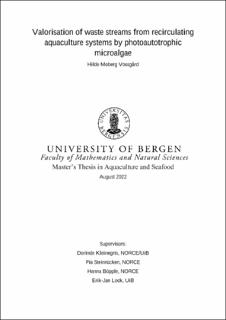| dc.description.abstract | The low water consumption in Recirculating Aquaculture Systems (RAS) can result in relatively high concentrations of polluting nutrients in effluent waste streams (WSs) compared to traditional Flow-through systems (FTS). These potentially valuable WSs are currently poorly exploited. It is known that photoautotrophic microalgae could be an option for WS valorisation as they can utilise these nutrients (mainly nitrogen (N) and phosphorous (P)). This thesis examined the suitability of various WSs (freshwater (FW) outlet water, sludge, and concentrated sludge and seawater (SW) outlet water) as nutrient sources for FW Chlorella vulgaris and SW Microchloropsis gaditana and the effect of different manipulations (autoclaving, sterile filtration, the addition of micro/macronutrients). Some samples underwent an enzymatic/chemical hydrolysis treatment conducted externally by LEITAT to liberate N and P and enhance microalgae nutrient availability. In this thesis, experiments were conducted with three different unit volumes: 2 mL in the well plate (WP), 300 mL in the bubble column, and 20 L in the photobioreactor (PBR). All WS samples were tested in the WP experiment with various manipulations. The results from the WP experiment were binary (growth (G) or no growth/fail (F)). One WS sample was selected for the bubble column experiment (FW, C. vulgaris), where the effect of micro/macronutrient addition was tested. Another WS sample was chosen for the PBR experiment (SW, M. gaditana), where it was tested unmanipulated. In the bubble column and PBR experiment, biomass development was assessed by OD, quantum yield (QY), nutrient analyses (N and P), dry weight (DW), total fatty acid (TFA) % of DW, and TFA composition. All the unmanipulated and untreated outlet sample media allowed algae growth in the WP experiment, while only 50% of the LEITAT-treated samples did. Generally, the binary results for most WS samples were unaffected by manipulation. Autoclaving had a growth-promoting effect in one sludge sample, as a G result only was registered after manipulation. Two LEITAT-treated samples were affected differently by micronutrient addition (inhibiting and algae growth promoting). The Bubble column and PBR experiment demonstrated that C. vulgaris and M. gaditana could utilise the nutrients in axenic FW and non-axenic SW waste streams, respectively. The macronutrient additions lacking effect on final OD and DW in the Bubble column experiment were questionable as the initial concentration of P in the WS medium was low, and intracellular P storage of the algae inoculum was not taken into account. However, earlier stress indications (elevated TFA % DW, changing TFA composition, and declining QY) were registered in cultures with lower initial P concentrations. This indicates that a repeated batch experiment could have uncovered P-limitations in an unmanipulated WS medium. The results from this thesis support previous findings that polluting nutrients in WSs from RAS can be utilised by photosynthetic microalgae but that algae growth in some WS might be inhibited or limited without further manipulations (autoclaving, micronutrient addition). The original N:P ratio of WSs will vary, but the results suggest that, generally, P will be the growth limiting element. | |
